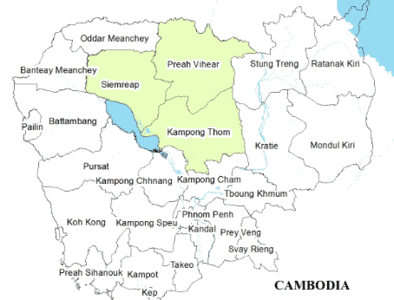Cambodia
Cambodia is a country in mainland Southeast Asia. Cambodia’s landscape is characterized by a low-lying central alluvial plain that is surrounded by uplands and low mountains and includes the Tonle Sap (Great Lake) and the upper reaches of the Mekong River delta. According to Cambodia Forest Cover 2016, forest covers approximately 45.0 percent of Cambodia's total land area (MoE, 2018), which despite being in decline, is a relatively high percentage when compared to other countries in Indo-Burma. Considering this, Cambodia is still in a good position to secure its wealth of valuable natural resources through landscape-level approaches to forest landscape restoration (FLR) and improved land management.
Cambodia’s Intended Nationally Determined Contribution is to restore 60 percent forest cover in 2030. The Royal Government of Cambodia (RGC) has commissioned the Ministry of Environment (MoE) to support forestry sector governance by “reducing greenhouse gas emissions from the forestry sector to zero percent before 2040”. In order to archive this commitment, MoE has put in place for implementation the three following strategic missions:
- achieving a balance between anthropogenic emissions by sources and removals by sinks of greenhouse gas emissions from the forestry sector;
- improving livelihood opportunities of local communities to reduce their dependence on forest products; and
- strengthening the production of timber and fuel wood from plantations and protect natural forests; the latter request having significant relevance for the future management of production forests.

IMPACTS
The Forest and Landscape Restoration Mechanism (FLRM) has been implemented in Cambodia since 2016 with an integrated landscape approach, taking into account the mosaic land use patterns and the diverse interests of stakeholders. The FLRM Work Plan 2016–2020 in Cambodia aims to achieve three main outputs including:
- enabling environment of FLR with actions focused on institutional arrangement, inter-sectoral coordination, integrated landscape governance, capacity strengthening, assessment and monitoring of FLR;
- resources mobilization through facilitation of the access of Cambodian institutions/organizations to both public and private investments and support innovative partnerships/initiatives on sustainable financing for FLR in the context of the sub-group on Forestry Sustainable Financing of Technical Working Group on Forestry Reform (TWG-FR); and
- pilot actions in Cambodia focused on implementation of innovative models in Kampong Thom, Preah Vihea & Siem Rea.
Check out:
- this video to learn more about FLRM in Cambodia; and
- this video prepared for social media.

